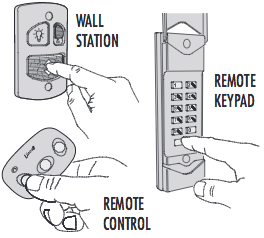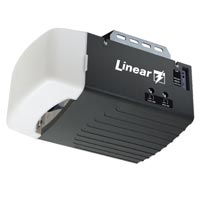If your Linear garage door remote is not working, check the batteries and reprogram it. Troubleshooting is essential for resolving common issues with your garage door remote.
When faced with problems like the remote not responding, failing to open or close the door, or working intermittently, it can be frustrating. However, following some simple troubleshooting steps can often resolve these issues and get your remote working properly again.
By understanding the common problems and how to address them, you can ensure the smooth and efficient operation of your linear garage door remote. Let’s explore some effective troubleshooting tips to help you get your garage door remote back in working order.

Credit: m.youtube.com
Introduction To Linear Garage Door Remote Issues
Are you encountering issues with your Linear garage door remote? Troubleshooting common problems can help. From checking battery levels to reprogramming the remote, understanding these simple fixes can save time and hassle.
Linear garage door remotes are an essential part of any garage door system. They allow you to operate your garage door from a distance, without having to get out of your car. However, like any other electronic device, garage door remotes can sometimes malfunction, causing inconvenience and frustration for homeowners. In this blog post, we will discuss the common symptoms of remote malfunctions and the importance of timely troubleshooting to ensure your garage door system operates smoothly.
Common Symptoms Of Remote Malfunctions
It is important to recognize the symptoms of remote malfunctions so that you can troubleshoot the problem before it becomes a major issue. Here are some common symptoms of remote malfunctions:
- The remote does not work at all.
- The remote works intermittently.
- The range of the remote is reduced.
- The remote button is stuck or does not click.
- The battery in the remote needs replacement.
If you experience any of these symptoms, it is important to troubleshoot the problem as soon as possible to prevent further issues.
Importance Of Timely Troubleshooting
Timely troubleshooting is crucial to ensuring your garage door system operates smoothly and efficiently. Ignoring the symptoms of remote malfunctions can lead to bigger problems, such as the door not opening or closing properly, or the door opening unexpectedly. This can be dangerous and pose a threat to your safety and security.
By troubleshooting the problem early on, you can save time and money in the long run. It is always best to address the issue when it is still small and manageable, rather than waiting for it to escalate into a larger problem.
In conclusion, it is important to be aware of the symptoms of remote malfunctions and to troubleshoot the problem as soon as possible. By doing so, you can ensure your garage door system operates smoothly and efficiently, providing you with peace of mind and convenience.
Initial Checks Before Troubleshooting
Before diving into troubleshooting, it’s crucial to perform initial checks on your Linear garage door remote. These checks can help identify common issues and potentially solve the problem without extensive troubleshooting.
Verifying Power Supply And Battery Life
Ensure the remote has good battery life and is receiving adequate power supply. Replace batteries if needed to avoid interruptions in signal transmission.
Ensuring a Clear Signal Path
Check for any obstructions that may be hindering the signal path between the remote and the garage door opener. Remove any barriers for a clear signal transmission.
Basic Troubleshooting Steps
When your linear garage door remote stops working, it can be frustrating. However, before calling for professional help, there are some basic troubleshooting steps you can take to resolve the issue. By following these simple procedures, you may be able to identify and fix the problem yourself, saving time and money.
Resetting The Remote
If your linear garage door remote is not working, the first step is to try resetting it. This can often resolve minor issues and restore the remote’s functionality. To reset the remote, follow these steps:
- Remove the batteries from the remote control.
- Press and hold the “reset” button on the remote for 10 seconds.
- Reinsert the batteries and test the remote to see if it is now working.
Reprogramming The Remote To The Opener
If resetting the remote does not solve the problem, you may need to reprogram it to the garage door opener. To do this, follow these steps:
- Locate the “learn” button on the garage door opener.
- Press and release the “learn” button. The indicator light will illuminate. You will have 30 seconds to complete the next step.
- Press and hold the button on the remote that you want to program. Release the button when the opener lights blink, indicating successful programming.
- Test the remote to ensure it is now working properly.
Dealing With Signal Interference
Identifying Sources Of Interference
When troubleshooting issues with your Linear garage door remote, it’s essential to first identify potential sources of signal interference. Common culprits include:
- Electronic devices such as routers, cordless phones, and baby monitors
- Metal objects or structures near the garage
- Power lines and electrical substations
Solutions To Overcome Interference
Overcoming signal interference requires implementing practical solutions to ensure the smooth operation of your garage door remote. Consider these strategies:
- Repositioning or relocating electronic devices to minimize signal overlap
- Installing a garage door remote with dual-frequency technology for improved signal reliability
- Utilizing a signal booster or range extender to enhance signal strength
Advanced Diagnostic Tips
When troubleshooting issues with your Linear garage door remote, advanced diagnostic tips can help pinpoint the root cause of the problem. By following these steps, you can identify and resolve issues with your remote efficiently, ensuring the smooth operation of your garage door.
Testing Remote Frequency
To begin troubleshooting, test the remote frequency to ensure it is functioning within the correct range. Use a frequency tester or consult the remote’s user manual for instructions on how to check the frequency. If the frequency is not within the expected range, it may indicate a problem with the remote’s transmission capabilities.
Inspecting Internal Components
Next, inspect the internal components of the remote for any visible damage or wear. Check the battery contacts, circuit board, and buttons for any signs of corrosion, loose connections, or physical damage. Additionally, ensure that the battery is properly installed and functioning. Any issues with the internal components can affect the remote’s performance.

Credit: veterangaragedoor.com
When To Replace Your Remote
If you are experiencing issues with your linear garage door remote, it may be time to consider a replacement. Knowing when to replace your remote can save you time and frustration. Below, we will discuss signs of irreversible damage and how to choose the right replacement.
Signs Of Irreversible Damage
Recognizing the signs of irreversible damage is crucial in determining if your linear garage door remote needs to be replaced. Common signs include physical damage such as cracked casing, unresponsive buttons, or intermittent functionality. If your remote exhibits any of these signs, it may be time for a replacement.
Choosing The Right Replacement
When selecting a replacement for your linear garage door remote, it’s important to consider compatibility with your existing garage door opener. Look for remotes that are compatible with your specific garage door model and frequency. Additionally, ensure that the replacement remote offers secure encryption to prevent unauthorized access.
Professional Help And Support
For effective Linear Garage Door remote troubleshooting, seek professional help and support. Expert assistance ensures quick and accurate resolution of any technical issues you may encounter with your garage door remote. Trust experienced professionals to provide the guidance and solutions needed for a seamless garage door operation.
When To Call A Technician
If basic troubleshooting fails, consider calling a professional technician.
Finding Authorized Service Centers
Ensure the service center is authorized for reliable support.
Professional help provides expert solutions for complex issues.
When to call a technician:
– If basic troubleshooting fails, seek professional help.
– Professional technicians can offer specialized assistance.
– Authorized service centers ensure quality and reliable support.
Finding authorized service centers:
1. Check the manufacturer’s website for authorized centers.
2. Verify the credentials and certifications of the service center.
3. Contact the manufacturer for a list of authorized service providers.
Seeking professional help ensures accurate diagnosis and efficient solutions.

Credit: support.garagedoorzone.com
Maintenance Tips To Prevent Future Issues
To prevent future issues with your linear garage door remote, regularly lubricate moving parts and check batteries for optimal performance. Ensure the remote is programmed correctly, and troubleshoot any signal interference promptly for smooth operation.
Regular maintenance of your linear garage door remote is critical to keeping it functioning optimally. Routine care and cleaning of the remote and garage door opener can prevent future issues and save you from costly repairs. Here are some tips to keep your garage door remote in top shape:.
Regular Cleaning And Care
Regular cleaning of your garage door remote can prevent dust and debris from interfering with the signal. Wipe the remote clean with a soft cloth and mild detergent. Avoid using harsh chemicals or abrasive materials that can damage the surface.
In addition to cleaning, ensure that the batteries are changed regularly to prevent low power that can affect the remote’s range. A good rule of thumb is to replace the batteries every six months or as needed.
Periodic Reviews Of System Settings
Periodically reviewing your garage door opener’s system settings can help prevent future issues. Check the settings to ensure that the door is opening and closing smoothly and not making any unusual noises. If you notice any issues, you should contact a professional technician to avoid causing further damage.
Ensure that the door’s safety features, such as the photo-eye sensors, are working correctly. Test the sensors by placing an object in the door’s path and check if the door reverses its direction.
In conclusion, by following these maintenance tips, you can prevent future issues with your Linear garage door remote and avoid costly repairs. Regular cleaning and care, along with periodic reviews of system settings, can help keep your garage door in optimal working condition.
Frequently Asked Questions
Why is my garage door not responding to the remote?
Check if the remote batteries are dead or need replacement. Ensure the remote is programmed correctly. Check the garage door motor and antenna for issues.
How do I reset the linear garage door opener remote?
To reset a linear garage door opener remote, locate the “learn” button on the opener and press it. Within 30 seconds, press the desired button on the remote. The opener light will blink, indicating successful programming.
Why is the red light blinking on my linear garage door opener?
The red light on your linear garage door opener blinks to indicate a problem with the safety sensors or the door’s alignment. Check for any obstructions in the sensor’s path and ensure that the door is properly aligned. If the issue persists, consult the user manual or contact a professional technician for assistance.
How to Reengage A Linear Garage Door Opener?
To reengage a linear garage door opener, locate the emergency release cord and pull it down to disengage the opener. Then, close the door manually until it clicks into place. Finally, pull the cord again to reengage the opener.
Why is my linear garage door remote not working?
The remote may need new batteries or reprogramming. Check for obstructions in the door’s path.
Conclusion
In troubleshooting your Linear garage door remote, follow these steps to quickly resolve issues. Regular maintenance can prevent future problems and ensure smooth operation. By understanding the common problems and solutions, you can save time and money. Keep your garage door remote working efficiently with these simple tips.
